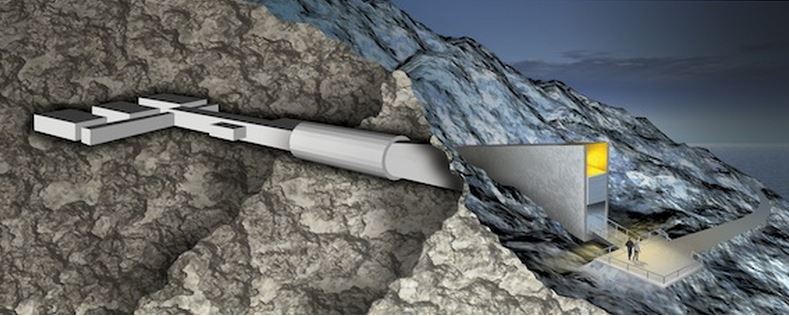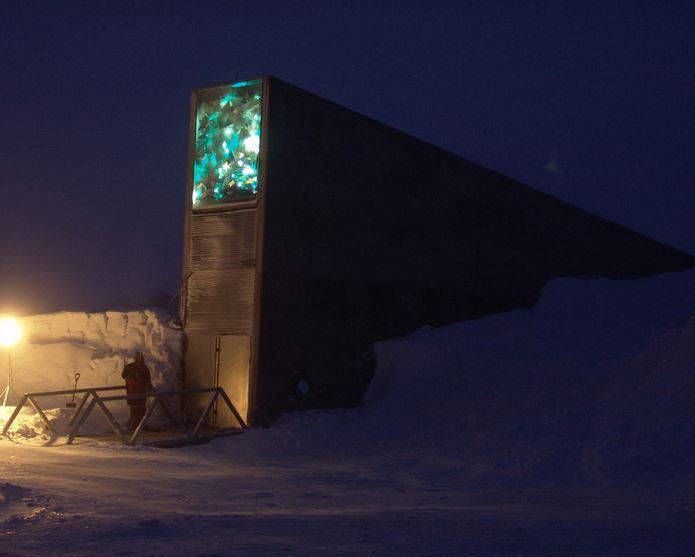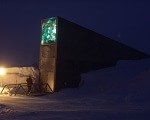The first delivery of forest tree species seeds have been accepted by the Svalbard Doomsday Vault, a secure seed bank on the island of Spitsbergen, Norway, in the remote Arctic Svalbard archipelago, just 810 miles (1,300 km) from the North Pole.
Known officially as the Svalbard Global Seed Vault, which is inside a mountain, it is designed to withstand virtually all human and natural disasters. The aim is to preserve a wide variety of plant seeds that are duplicate samples (spare copies) of seeds held in gene banks worldwide, to insure against the loss of seeds in other genebanks during regional or global catastrophes.
The seed vault is managed by the Global Crop Diversity Trust (GCDT), the Nordic Genetic Resource Center (NordGen), and the Norwegian Government.

The Svalbard Doomsday Vault is deep inside a mountain. Scientists say it can withstand virtually any natural or man-made catastrophe.
Samples of Norway spruce and Scots pine have entered the vault.
During this week, the Global Crop Diversity Trust said thousands of seeds from virtually every nation in the world will be deposited in the vault. They have been dispatched from every corner of the globe – from Benin in West Africa to the heart of the Rocky mountains, and will be added to the 839,000 samples already deposited there.
The deposit from just the United States contains seeds gathered from about 150 different countries.
Spanning 12,000 years of agricultural history
Every seed preserved in the vault has its own story, part of almost 12,000 years of agricultural heritage.
Benin is sending Oryza glaberrima, a rice species first domesticated in the inland delta of the River Niger more than 3,500 years ago.
Global Crop Diversity Trust said in a statement:
“Depositing these seeds in Svalbard secures their rich genetic reservoir. Plant breeders and scientists need access to the widest possible genetic diversity, to breed the new crops required now and in the future to feed a growing global population in a world facing numerous challenges.”
“These challenges range from climate change, to new pests and diseases, increasing pressures on agricultural land and more expensive inputs.”

The entrance to the Svalbard Global Seed Vault (Image: Norwegian Government)
The preservation of native species is also important for repopulation efforts. For example in the US, there is today a greater focus on making sure there are sufficient quantities and varieties of native seeds available for restoration efforts following floods, wildfires and other natural disasters that could otherwise damage natural ecosystems permanently.
Parliamentary State Secretary at the German Ministry of Food and Agriculture, Peter Bleser, who was at the Vault during the deposit said:
“The work of the Svalbard Global Seed Vault and the Crop Trust to conserve crop diversity here in the arctic cold and across the world is essential for the success of agriculture in the future.”
“I am proud to say that the Federal Republic of Germany has sent more than 40,000 samples of crops to the Seed Vault and continues to support the work of the Global Crop Diversity Trust.”
Seed Curator at the United States Department of Agriculture, Dr. Stephanie Greene, said:
“Preserving crop diversity – the wonderful plant genetic resources that live and grow in our own backyard – is an area where we can really make a difference.”
“Working in partnership with the Crop Trust, the USDA is able to have a ‘back-up for our back-up’. We already have 69,000 accessions safely stored in the Seed Vault at Svalbard. The latest shipment adds nearly 20,000 more, from around 650 species, including a large proportion of varieties unique to the US. Almost 20% of the entire US collection is now stored at Svalbard. This partnership approach ensures these resources remain available for future generations.”
Video – The Seed Vault
Professor Cary Fowler, former executive director of the Global Crop Diversity Trust, currently serving as a Senior Advisor to the trust, tells the story of Global Crop Diversity and the seed vault.

